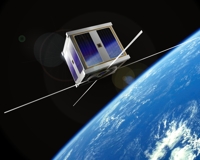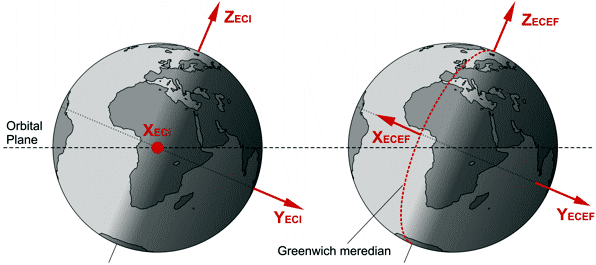
|
|
The following pages will contain information about orbital mechanics, models and properties. It will give
an overview over different orbital terms used to describe the orbital motion of a satellite.
|

To calculate orbital motions and positions in three dimensional space
it requires a number of orbital parameters. These are given
beforehand, calculated or given by observations, as in case of the
Two Line Elements (TLE), which will be described here.
Further it requires the current time and the time at which an
orbiting object was in a specific position. This time is also measured
and defined in a certain format called
Julian Date.
The Coordinate Frames
To define an orbit around Earth, two specific Earth related coordinate
systems are given beforehand. They both have their origin in the
geometrical center of Earth and are named the
Earth Centered Inertial
(ECI) coordinate frame and the
Earth Centered Earth Fixed (ECEF)
coordinate frame.
 The ECI Coordinate Frame
The ECI Coordinate Frame
The term ECI stands for Earth
Centered Inertial and represents a coordinate system with origin in
the center of Earth, which is fixed relative to the Earth rotation.
Its X-axis is parallel to the Vernal Equinox (The rotational axis of the Earth is tilted relative to its orbital
plane) and its Z-axis, which is parallel with the Earth rotational
axis.
The ECEF Coordinate Frame
The second coordinate frame
is the Earth Centered Earth Fixed (ECEF) coordinate frame. In this
frame the X-axis is passing through the zero longitude, also known
as Greenwich meridian, and has a Z-axis parallel with the rotational
axis. In this way the ECEF frame is fixed to the earth itself and
rotates around with it.











 To calculate orbital motions and positions in three dimensional space
it requires a number of orbital parameters. These are given
beforehand, calculated or given by observations, as in case of the
Two Line Elements (TLE), which will be described here.
To calculate orbital motions and positions in three dimensional space
it requires a number of orbital parameters. These are given
beforehand, calculated or given by observations, as in case of the
Two Line Elements (TLE), which will be described here.